6.1 Voting Procedures
The action of casting a vote might seem rather ordinary, but there are important mechanical and logistical aspects of voting that help elections run smoothly.
The Voting Location
The starting point of casting a ballot is determining where to vote. Election laws will specify the minimum requirements for a voting location (sometimes called a voting station, polling place, or precinct). These factors might include geographic proximity to voters, adequate size to accommodate voters, accessibility features, and basic amenities such as electricity, furniture, and restrooms. According to the ACE Electoral Knowledge Network (n.d.-g), the layout of a voting location must balance several features:
Efficiency
The polling site must facilitate the flow of voters in and out of the facility.
Secrecy
Voting compartments, such as privacy screens or voting booths, must be present to ensure the secrecy of voting.
Transparency
A voting process in which voters can see their ballot being inserted into a ballot box or a counting machine.
Accessibility
An ideal voting place is barrier-free and accessible for people with mobility issues.
Security
Physical security of the ballots should be maintained.
There will also be provisions for a minimum number of voting locations to ensure that distance is not an obstacle to casting a vote. For example, in Canada, the median distance voters typically travel to a polling location is less than one kilometre (Garnett & Grogan, 2021).
Casting a Vote
After travelling to a voting location, voters can cast their vote. Casting a ballot involves several discrete steps: authentication, ballot marking, and ballot insertion (Herron & Smith, 2016). The voting location must have sufficient space to accommodate this process. It must also accommodate the voters, election officials, and the required election materials. Click on the image below for a description of the voting process at a typical voting location in Canada.
Activity Description
- Voter enters. Information Officer verifies that voter is at the correct location.
- If voter needs to register, they are sent to the Registration Officer to verify their identity and have their name added to the voter roll.
- Once authenticated, voter obtains ballot from Poll Clerk.
- Voter marks their ballot behind a privacy screen.
- Voter returns folded ballot to Deputy Returning Officer, who inserts completed ballot into ballot box.
- Candidate and party representatives (called scrutineers or poll watchers) may be present to observe the process.
- The Central Poll Supervisor handles questions, complaints, and disputes.
- The full flow of the steps listed above.

2. If voter needs to register, they are sent to the Registration Officer to verify their identity and have their name added to the voter roll.
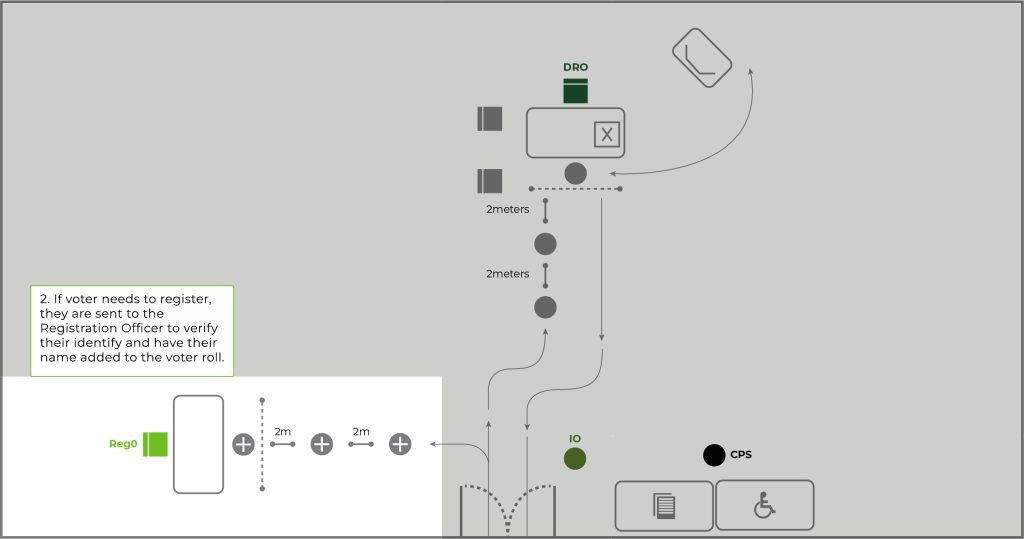
3. Once authenticated, voter obtains ballot from Poll Clerk.
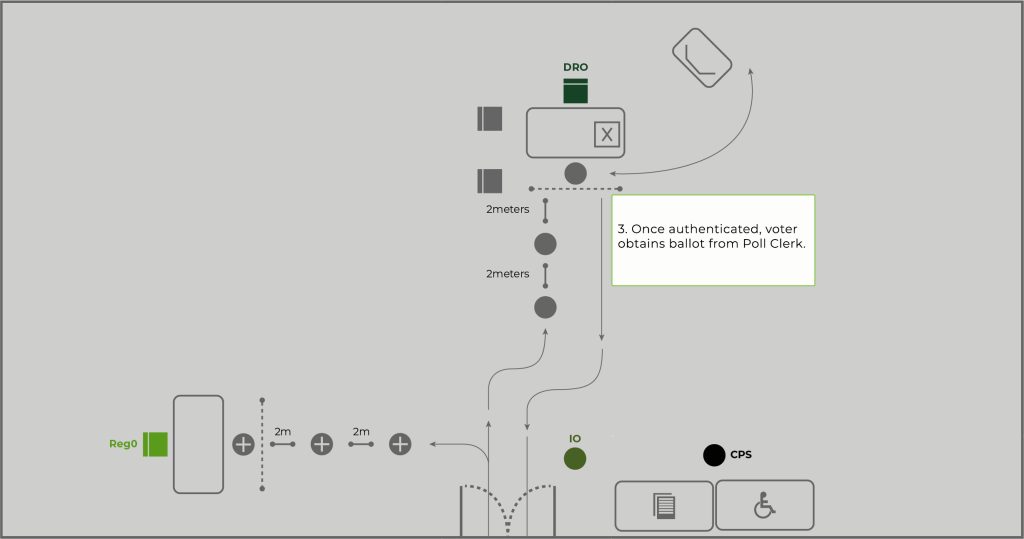
4. Voter marks their ballot behind privacy screen.
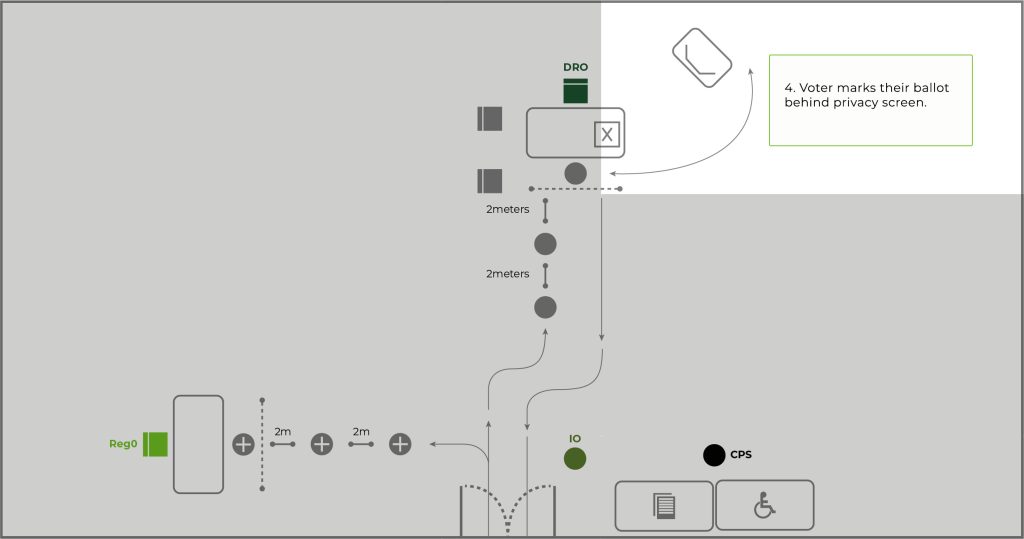
5. Voter returns folded ballot to Deputy Returning Officer, who inserts completed ballot into ballot box.
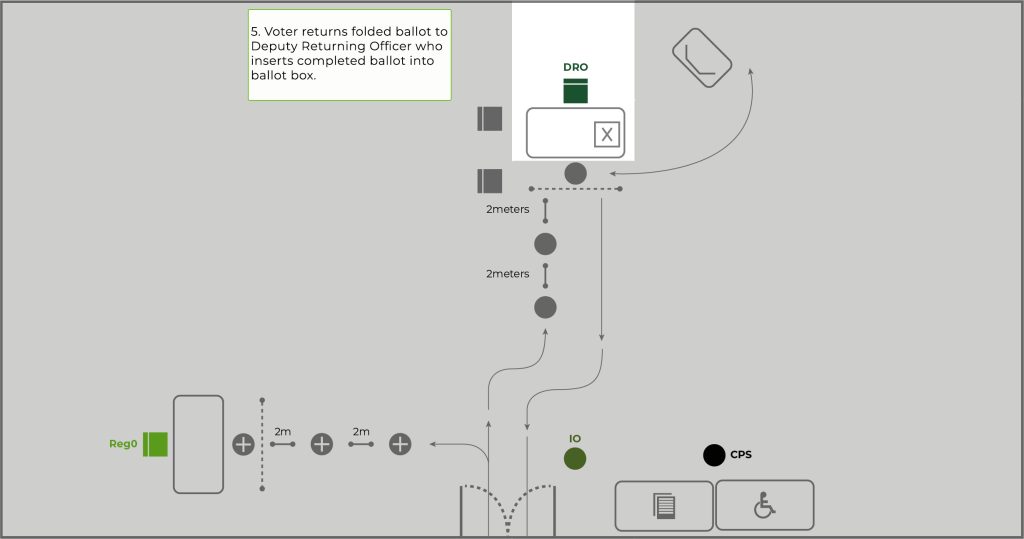
6. Candidate and party representatives (called scrutineers or poll watchers) may be present to observe the process.
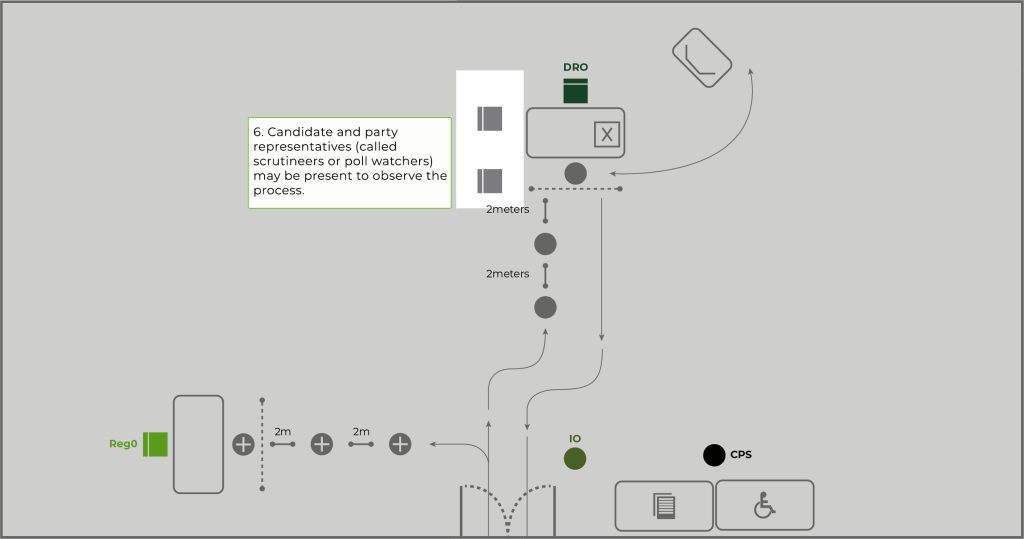
7. The Central Poll Supervisor handles questions, complaints, and disputes.
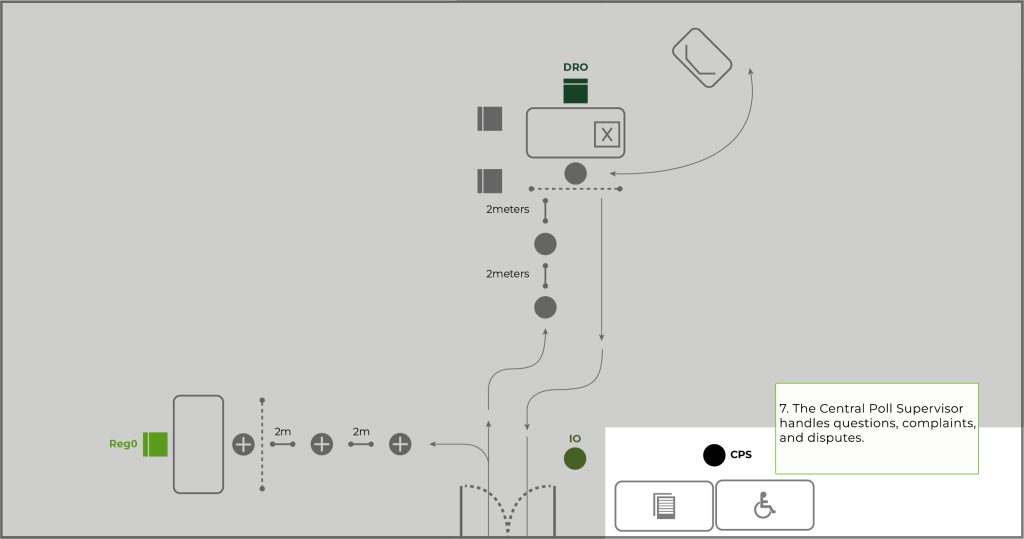
8. The full flow of the steps listed above.
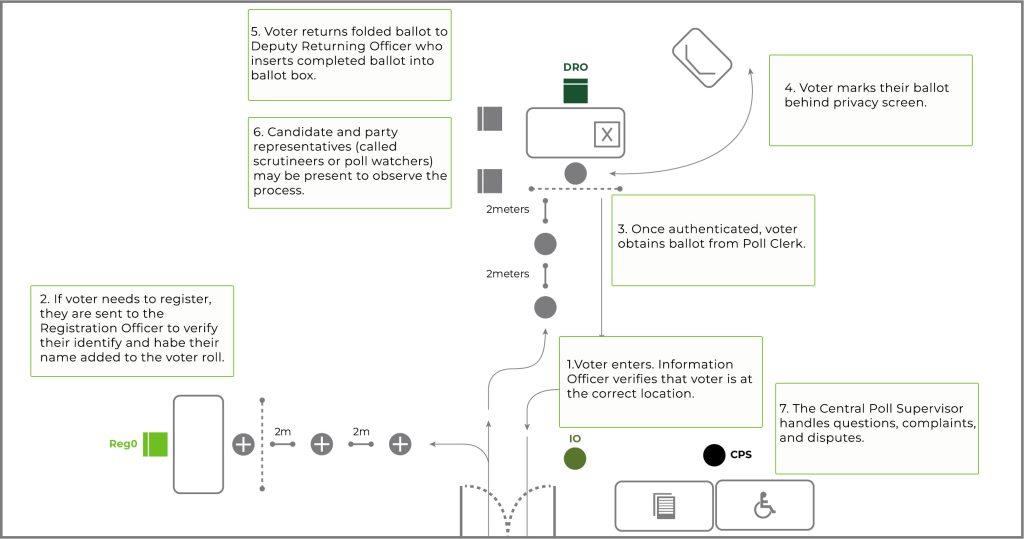
Created by Fanshawe College. Content reference: Central Poll Supervisor Guidebook from Elections Canada.
The layout and organization of a polling location will vary, depending on space and resources. For example, using smaller spaces with fewer voting booths can increase wait times and have a negative impact on the overall voting experience (Herron & Smith, 2016). There are also minimum criteria to consider when selecting voting locations. The checklist below provides examples of the factors used in Canada to identify potential polling places.
How to choose a voting location?
Public Transit
- Public transit stop near the polling place? (Yes/No)
Parking
- Parking available? (Yes/No)
- Number of available parking spaces on the property:
- Parking space(s) for persons with disabilities? (Yes/No)
- Surface of parking firm and level? (Yes/No)
- Parking lit? (Yes/No)
- Pathway from parking lot to the entrance? (Yes/No)
Building Exterior
- Sloping sidewalk (curb cut)? (Yes/No)
- [Mandatory accessibility criterion] Surface of the pathway is firm and obstacle-free? (Yes/No)
- [Mandatory accessibility criterion] Pathway is at least 920 mm (36″) wide? (Yes/No)
- At the narrowest point the pathway measures (mm):
- Pathway is free of a long slope? (Yes/No)
- Pathway is free of a steep incline? (Yes/No)
- [Mandatory accessibility criterion] Building provides a level access to the entrance? (no steps) (Yes/No)
- Level access ramp is provided? (Yes/No)
- If there is a level access ramp, it provides:
- Handrail? (Yes/No)
- Non-slip surface? (Yes/No)
- Clear width of 920 mm (36″)? (Yes/No)
- What is the width of the ramp (mm)?
- A slope of no more than 4.80°? (Yes/No)
- Indicate the steepest result: (# of degrees)
- [Mandatory accessibility criterion] Exterior building lighting? (Yes/No)
- [Mandatory accessibility criterion] Building exterior is free of any protruding objects? (Yes/No)
- There is signage to locate the level access entrance? (Yes/No)
Building Entrance
- [Mandatory accessibility criterion] Exterior door has a clear opening width of 810 mm (32″)? (Yes/No)
- Opening width of this door measures (mm):
- Door handles are easy to grip? (Yes/No)
- [Mandatory accessibility criterion] Door threshold meets maximum standard of 6 mm (1/4″)? (Yes/No)
- An automatic door opening device is provided (Yes/No)
- [Mandatory accessibility criterion] Weight of the entrance door allows it to be easily opened? (Yes/No)
- Door gives immediate access to the voting room? (Yes/No)
Note: If yes, go to question 30.
Building Interior
- [Mandatory accessibility criterion] Interior door(s) has a clear opening width of 810 mm (32″)? (Yes/No)
- Interior door opening width measurements (mm):
- Door handles are easy to grip? (Yes/No)
- Automatic door opening devices are provided for interior doors? (Yes/No
- [Mandatory accessibility criterion] Weight of interior doors allows them to be easily opened? (Yes/No)
- [Mandatory accessibility criterion] Door threshold meets maximum standard of 6 mm (1/4″)? (Yes/No)
- [Mandatory accessibility criterion] Corridors have a minimum width of 920 mm (36″)? (Yes/No)
- Minimum width of the corridor(s) measures (mm):
- [Mandatory accessibility criterion] Interior of the building is free of any protruding objects? (Yes/No)
- [Mandatory accessibility criterion] Voting room is on the same level as the entrance? (Yes/No)
- If no, can electors access the voting room using an elevator or a level access ramp? (Yes/No)
- If use of an elevator is required, is a key necessary to operate it? (Yes/No) If yes, who is the contact person for the key?
- If electors must use a ramp to access the voting room, this ramp provides:
- Handrail? (Yes/No)
- Non-slip surface? (Yes/No)
- Clear width of 920 mm (36″)? (Yes/No)
- What is the width of the ramp (mm):
- A slope of no more than 4.80°? (Yes/No)
- Indicate the steepest result: (# of degrees)
- [Mandatory accessibility criterion] Interior lighting works? (Yes/No)
- Wheelchair accessible washroom (Yes/No)
- Are there any grab bars? (Yes/No)
Overall Evaluation
- Does this site meet all the mandatory accessibility criteria? (Yes/No)
- If not, is it possible to modify the site so that it will meet all the mandatory criteria? (Yes/No)
Was the evaluation done on-site? (Yes/No)
If yes, when (mm/dd/yy): By whom:
Polling Place Suitability Checklist by Elections Canada. Used under Non-commercial Reproduction terms. This is a copy of the version available at: Polling Place Suitability Checklist.
Does Location Matter?
 Ultimately, voting imposes a time cost on voters (Blais et al. 2021), and when that cost increases, voters may be less likely to vote in the future. Some research suggests that waiting an additional hour to vote decreases the probability of future voting by one percentage point (Pettigrew, 2021). However, location is only one factor in creating an efficient voting process. In some places, voting may take longer due to the type of system, complexity of the ballot, or the voting procedures in place. Different voting technologies have the potential to reduce the time required to vote. That’s what we will look at next.
Ultimately, voting imposes a time cost on voters (Blais et al. 2021), and when that cost increases, voters may be less likely to vote in the future. Some research suggests that waiting an additional hour to vote decreases the probability of future voting by one percentage point (Pettigrew, 2021). However, location is only one factor in creating an efficient voting process. In some places, voting may take longer due to the type of system, complexity of the ballot, or the voting procedures in place. Different voting technologies have the potential to reduce the time required to vote. That’s what we will look at next.

